Human body. People sometimes call the human body a machine—the most wonderful one ever built. Of course, the human body is not a machine. But it can be compared to one in many ways. Like a machine, the body is made up of many parts. Each part of the body, like each part of a machine, does special jobs. But all the parts work together and so make the body or the machine run smoothly. Also like a machine, the body needs energy to work. In such a machine as an automobile, the energy comes from gasoline. In the body, it comes from food or oxygen.
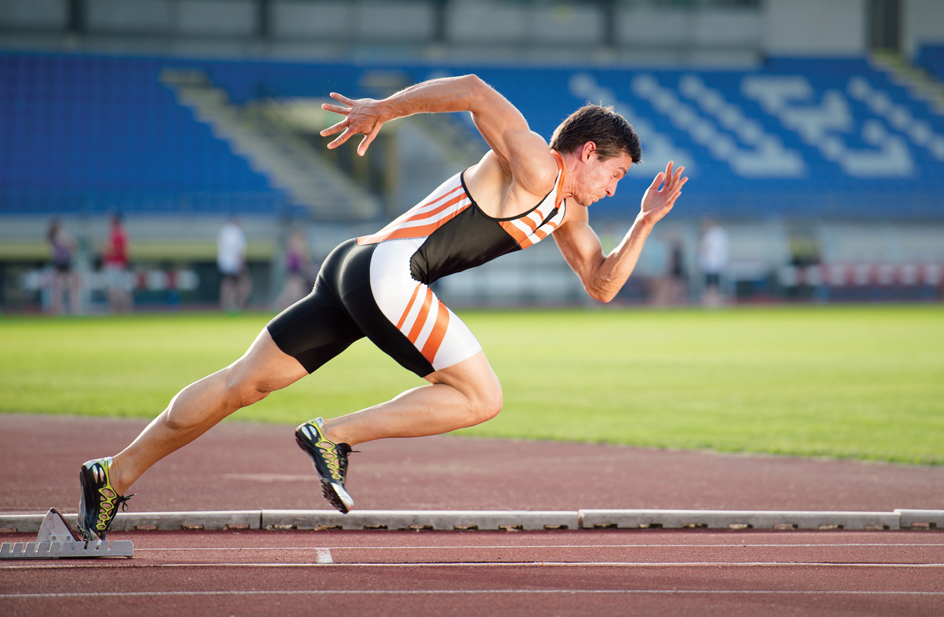
Although the human body can be compared to a machine, it is far more amazing than any machine. It can do things that no machine can do. For example, the body can grow. The body starts out as one cell. In time, this tiny cell develops into a body consisting of trillions of cells. The human body can also replace certain worn-out parts. Each day, several billion cells in the body die and are replaced by cell division. Thus, the body is always rebuilding itself. Every 35 to 45 days, for instance, the human body replaces the outermost layer of skin.
The human body can defend itself against hundreds of diseases. The body can also repair itself after most small injuries. Many body parts, such as the heart and kidneys, work continuously. The heart of a 70-year-old person, for example, has pumped about 55 million gallons (208 million liters) of blood during that person’s life. The person’s kidneys have also removed wastes from more than 1 million gallons (3.8 million liters) of blood.
By using its senses, the body can detect changes in its surroundings, such as changes in temperature, light, or sounds. It can adjust to these changes quickly. The body’s senses are truly incredible. For instance, people can learn to identify thousands of odors, yet smell is one of the least developed senses in human beings. The human body can also detect changes that occur within itself, such as changes in body temperature. The various parts of the body continuously adjust their activities to keep the “inside” environment normal. Such adjustments rely on a system of nerves that carries messages from one part of the body to another. The messages travel at speeds of up to 400 to 425 feet (120 to 130 meters) per second.
The most remarkable part of the human body is the brain. The human brain is so highly developed that it makes people different from all other living things. Their magnificent brain makes people able to think. They can compose silly rhymes or beautiful poetry. They can imagine a dream world or study the mysteries of the atom. No animal—no matter how smart—and no computer—no matter how powerful—can think like a human being.
What the body is made of
The human body has many parts. This section of the article describes the organization of the body, from its smallest parts through its largest ones.
Chemical elements and molecules.
Like all things—living and nonliving—the human body consists of atoms of chemical elements. The most common chemical elements in the body are carbon, hydrogen, nitrogen, and oxygen. The body also contains smaller amounts of many other elements, including calcium, iron, phosphorus, potassium, and sodium.
Atoms of chemical elements combine and form microscopic compounds called molecules. The most common molecule in the human body is water. A molecule of water consists of two atoms of hydrogen and one atom of oxygen. Water usually makes up 55 to 65 percent of the body. Most of the chemical reactions that occur in the body require water.
Except for water, all of the chief molecules in the body contain the element carbon. The most important carbon-containing molecules are large, complicated compounds called macromolecules. There are four main kinds of macromolecules in the body: carbohydrates, lipids, proteins, and nucleic acids. Carbohydrates provide energy that powers all the body’s activities. Lipids have several jobs. Some lipids, particularly the fats, store extra fuel. Other lipids serve as one of the building materials for the cells that make up the body. Proteins also have various duties. Many proteins serve as building blocks for cells. Other proteins, called enzymes, speed up the chemical reactions within the body. Nucleic acids carry instructions that tell each cell how to perform its particular jobs. For more information on macromolecules, see the article Life (The chemical basis of life) .
Cells and tissues.
The cell is the basic unit of all living things. The cells of the human body consist chiefly of molecules of water, proteins, nucleic acids, and lipids. The molecules that make up the cells are not alive, but the cells themselves are living things. Each of the body’s cells is able to take in food, get rid of wastes, and grow. Most of the cells can also reproduce. A thin covering consisting of proteins and lipid molecules encloses each cell. This covering permits only certain substances to enter or leave the cell.
Nearly all the cells in the body are too tiny to see without a microscope. Yet packed within each cell is the machinery that the cell needs to carry out its many activities. For a detailed discussion of a cell’s machinery and how it works, see the article Cell (Inside a living cell) (The work of a cell) .
The body has many basic kinds of cells, such as blood cells, muscle cells, and nerve cells. Each kind of cell has special features and jobs.
Cells of the same type form tissues. The body has four chief kinds of tissues. (1) Connective tissue helps support and join together various parts of the body. Most connective tissue is strong and elastic. (2) Epithelial tissue covers the body surface and so forms the skin. It also lines the mouth, the throat, and other passages and cavities inside the body. Epithelial tissue prevents harmful substances from entering the body. (3) Muscle tissue consists of threadlike fibers that can contract (shorten). Muscle tissue makes it possible for the body to move. (4) Nervous tissue carries signals. It permits various parts of the body to communicate with one another.
Organs and organ systems.
An organ consists of two or more kinds of tissues joined into one structure that has a certain task. The heart, for example, is an organ whose job is to pump blood throughout the body. Connective tissue, epithelial tissue, muscle tissue, and nervous tissue make up the heart.
Groups of organs form organ systems. Each organ system carries out a major activity in the body. For example, the digestive system consists of various organs that enable the body to use food. Similarly, the nervous system is made up of organs that carry messages from one part of the body to another and processes them. The remainder of this article discusses the main organ systems of the human body. For more detailed descriptions of the major organs and organ systems, see the articles listed in the Related articles at the end of this article.
The skin
The skin is the largest organ of the body. The skin, including nails, hair, and sweat glands, is sometimes called the integumentary system. If the skin of a 150-pound (68-kilogram) person were spread out flat, it would cover approximately 20 square feet (1.9 square meters). Skin has three layers: the epidermis, the dermis, and subcutaneous tissues.
The epidermis
forms the outermost layer of the skin. It serves as a barrier between the outside world and the inner tissues of the body. The outer portion of the epidermis consists of tough, dead cells that prevent bacteria, chemicals, and other harmful substances from entering the body. It also protects the body’s inner tissues from the harsh rays of the sun and prevents the loss of water from these tissues.
The dermis
is the middle layer of the skin. The dermis helps keep the temperature of the body within its normal range. The body produces tremendous amounts of heat as it uses food. Some of this heat escapes from the body through the blood vessels in the dermis. When the body needs to retain heat, these blood vessels narrow and so limit heat loss. When the body needs to give off heat, the blood vessels in the dermis expand and so increase heat loss. The sweat glands, which come from the epidermis, also help control body temperature. These glands produce sweat, which is released through pores on the skin surface. As the sweat evaporates from the surface, it cools the body.
The dermis also serves as an important sense organ. Nerve endings within the dermis respond to cold, heat, pain, pressure, and touch.
Subcutaneous tissues
lie directly beneath the dermis. They provide extra fuel for the body. The fuel is stored in fat cells. Subcutaneous tissues also help retain body heat and cushion the inner tissues against blows to the body.
The skeletal system
The skeleton of an adult consists of more than 200 bones. The skeleton forms a strong framework that supports the body. It also helps protect the internal organs. For example, the brain is shielded by the skull, the spinal cord by the spinal column, and the heart and lungs by the ribs.
The skeleton works together with the muscles in enabling the body to move. The bones of the shoulders and arms, for instance, serve as levers against which the muscles that move the arm can pull. The place where bones meet is called a joint. There are two basic kinds of joints. (1) Movable joints, such as the elbow, knee, and shoulder joints, permit varying degrees of motion. The bones of a movable joint are held together by bundles of tough, flexible connective tissue called ligaments. (2) Immovable joints do not permit any movement of the bones. The bones of the skull, except for the jawbones, meet in immovable joints.
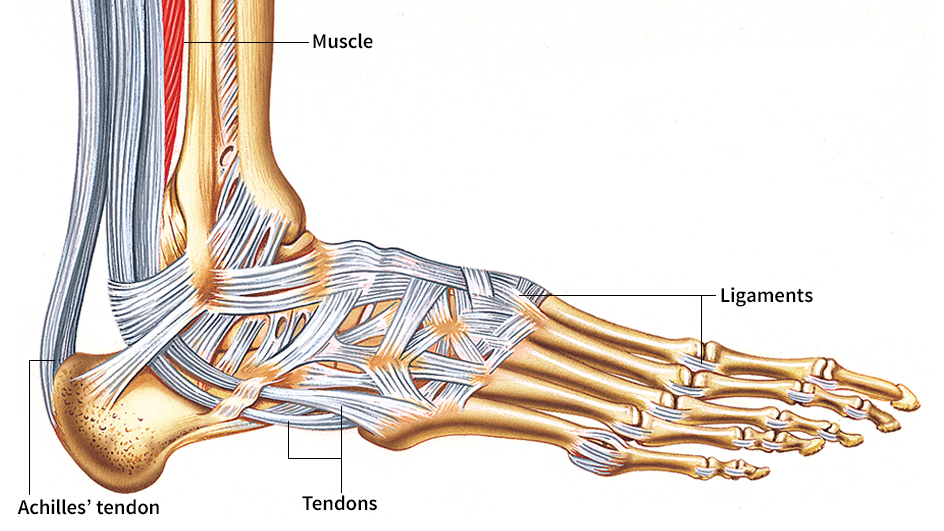
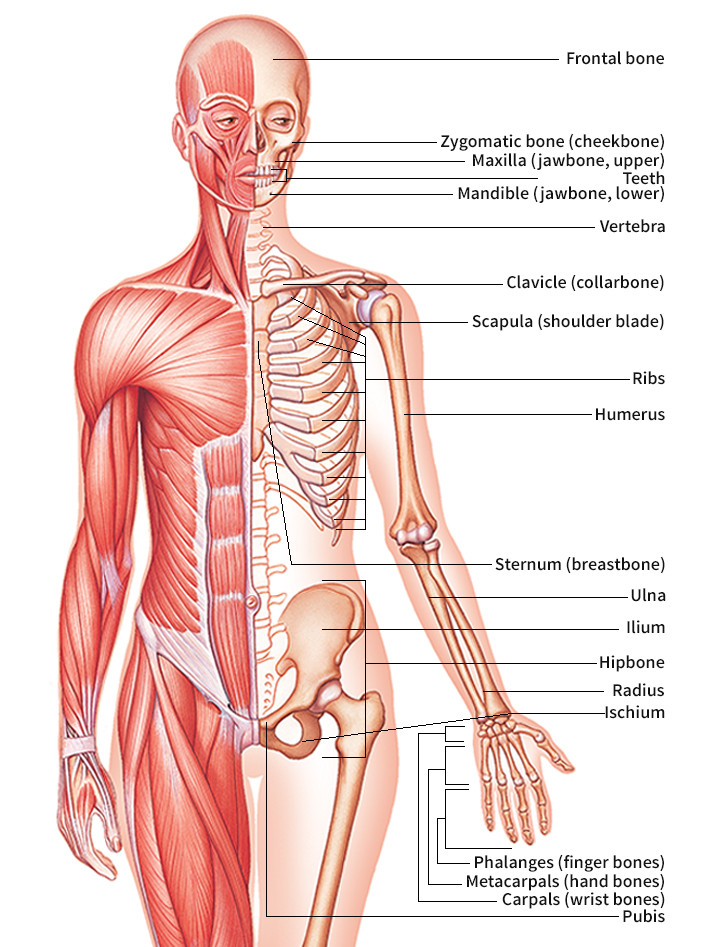
The skeleton serves as more than a framework for the body and a system of levers to help move the body. Bone tissue contains various kinds of cells that play a major role in keeping the blood healthy. The cells of red bone _marrow—_the soft, fatty core of many bones—produce new blood cells and release them into the bloodstream. Yellow bone marrow, the most common type of marrow in the adult skeleton, stores fat. Yellow bone marrow does not normally produce blood cells.
Two kinds of bone cells regulate the mineral content of the blood. One kind removes calcium, phosphorus, and other minerals from the blood and deposits them in the bone. The other kind dissolves old mineral deposits and releases the minerals back into the bloodstream as needed.
The muscular system
The muscular system moves the body. The body has more than 600 muscles, each of which consists of special fibers that can contract. When a muscle contracts, it pulls the tissue to which it is attached. This pulling results in movement.
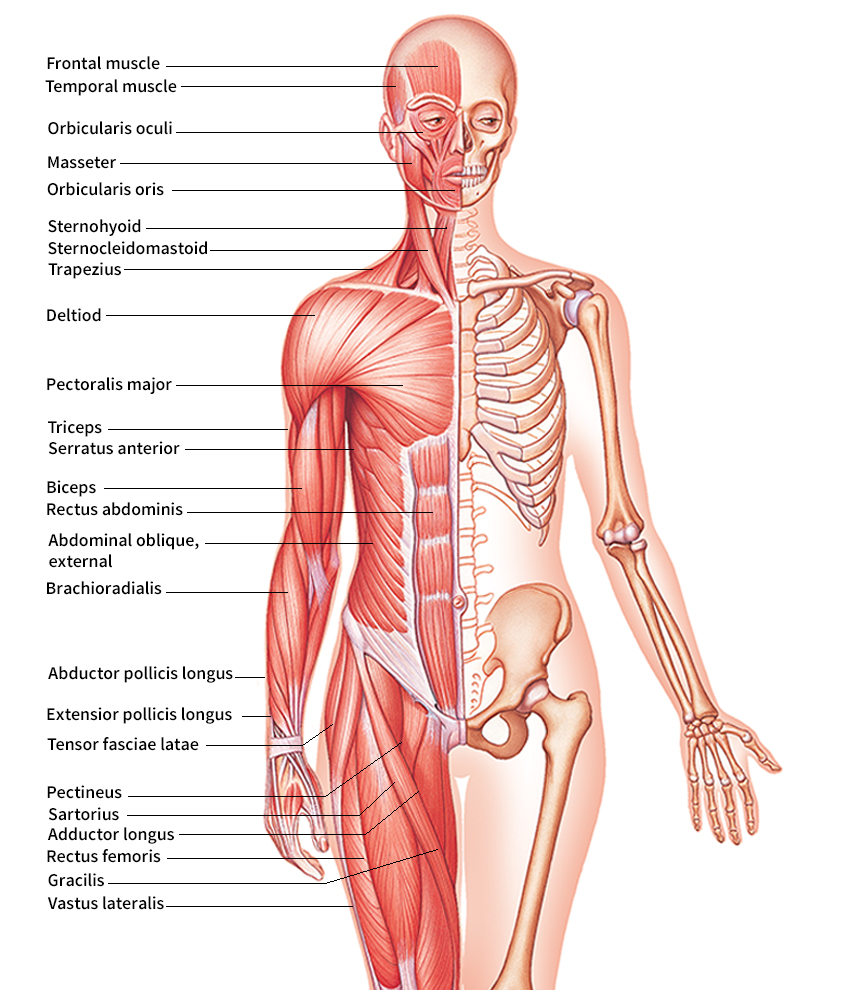
The muscles of the human body can be divided into two main types: (1) skeletal muscles and (2) smooth muscles. A third kind of muscle, cardiac muscle, is found only in the heart. It has features of both skeletal muscle and smooth muscle.
Skeletal muscles
are attached to the bones. They move the bones of the arms, legs, fingers, and other parts of the skeleton. We can consciously control the skeletal muscles, and so they are known as voluntary muscles. The fibers that make up a skeletal muscle have alternate light and dark crossbands called striations.
One end of each skeletal muscle is attached to a bone that does not move when the muscle contracts. In most cases, the other end of the muscle is attached to another bone, either directly or by means of cordlike bundles of connective tissue called tendons. This second bone moves when the muscle contracts.
Muscles move the body only by pulling. They cannot push the tissues to which they are attached. Two sets of muscles therefore control most skeletal movements, such as the raising and then lowering of the forearm. One set pulls the bones in one direction, and the other set pulls the bones in the opposite direction. For example, one set of muscles pulls the forearm up, but it cannot push the forearm down. To lower the forearm, a second set of muscles must contract and pull it down.
Smooth muscles
are found in most of the body’s internal organs. Unlike skeletal muscles, smooth muscles do not have striations. Smooth muscles in the walls of the stomach and intestines move food through the digestive system. Smooth muscles also control the diameter of the blood vessels and the size of the breathing passages. In all these cases, the smooth muscles contract and relax automatically—that is, we do not consciously control them. For this reason, they are often called involuntary muscles.
Smooth muscles cannot contract as rapidly as skeletal muscles. But smooth muscles can contract more completely than skeletal muscles and do not tire as quickly. Smooth muscles can thus produce powerful, rhythmic contractions over long periods.
Cardiac muscle
has striations like skeletal muscle. But like smooth muscle, it contracts automatically and rhythmically without tiring. Cardiac muscle enables the heart to beat an average of 70 times a minute without rest throughout a person’s lifetime.
The digestive system
The digestive system breaks down food into simple substances that the cells can use. It then absorbs these substances into the bloodstream and eliminates any leftover waste matter.
The main part of the digestive system is a long tube called the alimentary canal. This tube consists of (1) the mouth, esophagus, and stomach; and (2) the small intestine and large intestine. Other parts of the digestive system include the gallbladder, liver, pancreas, salivary glands, and teeth.

The mouth, esophagus, and stomach.
Digestion begins in the mouth, where the teeth tear and grind food into small pieces. Small pieces of food are more easily broken down during the digestive process than large ones. Therefore, thorough chewing is important. As food is chewed, three pairs of large salivary glands pour saliva into the mouth. Saliva moistens the food, making it easier to swallow. Saliva also contains the first of the system’s several digestive enzymes. The digestive enzymes break food down into smaller molecules the body can use.
Loading the player...
Digestion
After the food is swallowed, it enters the esophagus. The esophagus is a long, muscular tube that leads to the stomach. Contractions of smooth muscles move the food down the esophagus and into the stomach. The stomach is the widest part of the alimentary canal. It serves as a sort of ”holding tank” in which food remains for several hours. During this time, the stomach produces an acid and an enzyme that further break down much of the food. Muscle contractions mix the partly digested food into a mass called chyme.
The small intestine and large intestine.
Chyme passes from the stomach into the small intestine at a steady rate. Various digestive enzymes complete the breakdown of the food within the first section of the small intestine. The small intestine produces some of these enzymes. The rest are made by the pancreas. The pancreatic enzymes empty into the small intestine through a duct (tube). Bile, a liquid made by the liver and stored in the gallbladder, also enters the small intestine through the same duct in most people. Bile does not contain digestive enzymes, but it aids digestion by breaking up large molecules of fatty foods.
By the time the food leaves the first section of the small intestine, it has been mainly digested. Special cells line the walls of the remainder of the small intestine. These cells absorb useful substances from the digested food. The absorbed substances enter the blood and the lymph. Some of the substances are carried directly to cells throughout the body. The rest are transported to the liver. The liver stores some of the substances, releasing them as the body requires. It chemically alters the other substances, changing them into forms needed by the body.
The substances not absorbed by the small intestine pass to the large intestine. These substances consist of water, chemicals, vitamins, and wastes. The large intestine absorbs most of the water and chemicals, including sodium and chloride, and some vitamins, which then enter the bloodstream. The wastes move toward the anal canal, the end of the large intestine, and leave the body as bowel movements.
The respiratory system
The respiratory system consists of the organs of breathing. These organs include the nose, the trachea (windpipe), larynx (the voice box), pharynx (the cavity behind the nose and mouth), and a pair of lungs. The respiratory system has two main jobs. (1) It provides the body with oxygen. (2) It rids the body of carbon dioxide. The cells of the body need oxygen to break down and release the energy in food. During this process, carbon dioxide forms as a waste product.

Breathing involves the acts of inhaling and exhaling. Inhaling occurs as the chest cavity expands. As the chest expands, so do the lungs. Air from the atmosphere rushes in and fills the enlarged lungs. Exhaling occurs as the chest cavity shrinks, which pushes air out of the lungs. Inhaling and exhaling result chiefly from contractions of the diaphragm, a large muscle that forms the floor of the chest cavity. As the diaphragm contracts, the cavity expands. As it relaxes, the cavity shrinks. The muscles that move the ribs also play a part in the breathing process.
The air passages.
When we inhale, air enters the body through the nose. Air may also enter through the mouth. The air flows from the nostrils to the nasal passages. The nasal passages are lined with tiny hairlike structures called cilia and a sticky substance called mucus. The cilia and the mucus filter dust and dirt from the air. In addition, cold air is warmed and moistened as it moves through the nasal passages. From the nose and mouth, the air passes through the pharynx and the larynx. The air then enters the trachea.
The trachea carries the air toward the lungs. Before reaching the lungs, the trachea splits into two tubes called the primary bronchi. Each tube enters one lung. Within the lungs, the primary bronchi divide into smaller and smaller tubes, finally branching into extremely tiny tubes called bronchioles. The bronchioles end in hundreds of millions of thin-walled structures called alveoli or air sacs. The alveoli give the lungs tremendous surface area. If the air sacs were flattened out, the lungs would cover from 600 to 1,000 square feet (56 to 93 square meters).
The exchange of carbon dioxide and oxygen
occurs in the alveoli. Each alveolus is surrounded by a network of small blood vessels. Like the alveoli, these vessels have extremely thin walls. Blood that enters the vessels has a high level of carbon dioxide, which it picked up from the body tissues. The carbon dioxide leaves the blood and moves through the walls of the blood vessels and alveoli into the lungs. Oxygen from the air inside the lungs then passes through the walls of the alveoli and blood vessels and into the blood. The oxygen-rich blood leaves the lungs and travels to the heart, which pumps it to cells throughout the body. The carbon dioxide is expelled from the lungs when we exhale.
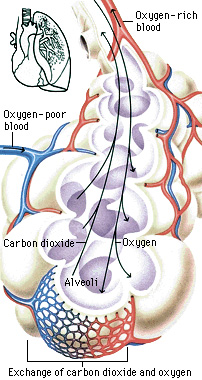
The circulatory system
The circulatory system moves blood throughout the body. Blood transports food and oxygen to the cells and carries away carbon dioxide and other wastes. The cells cannot live without a continuous supply of fresh blood. The circulatory system also carries disease-fighting substances called antibodies. In addition, it transports chemical messengers called hormones. Hormones are discussed in the section of this article called The endocrine system.

The circulatory system consists chiefly of (1) the heart, (2) the blood vessels, and (3) the blood.
The heart
is a hollow muscle that pumps blood through the circulatory system by contracting and relaxing rhythmically. The heart actually consists of two pumps that lie side by side. The left side of the heart makes up the stronger pump. It receives oxygen-rich blood from the lungs and sends it to cells throughout the body. The blood, which picks up carbon dioxide and other wastes from the cells, returns to the right side of the heart. This weaker pump moves the blood to the lungs and then back to the left side of the heart. In the lungs, the carbon dioxide is removed from the blood, and oxygen is added.
The blood vessels
form a branching network of about 60,000 miles (100,000 kilometers). They can be divided into three types (1) Arteries carry blood from the heart. (2) Veins carry blood to the heart. (3) Capillaries connect the arteries and veins.
Blood leaves the left side of the heart through the aorta. This vessel is the largest artery in the body. Several major arteries branch off the aorta. These arteries, in turn, divide into smaller and smaller vessels. Finally, the smallest arteries empty into the tiny capillaries. Through the thin walls of the capillaries, food and oxygen in the blood are exchanged for carbon dioxide and other wastes from individual cells.
From the capillaries, the blood enters small veins, which join larger and larger veins. Finally, it enters the right side of the heart through the superior vena cava and inferior vena cava, the body’s two largest veins. The right side of the heart then pumps the blood through the pulmonary arteries to the capillaries surrounding air sacs in the lungs. The oxygen-rich blood returns from the lungs to the left side of the heart through four pulmonary veins. The left side of the heart then pumps the blood out through the aorta, and the blood’s journey begins again.
The blood
consists of a liquid and three kinds of cells called formed elements. The liquid, which makes up 50 to 60 percent of the total volume of blood, is known as plasma. It carries many important substances. The digested food that enters the blood from the intestines and liver dissolves in the plasma, much as sugar dissolves in water. The plasma transports the dissolved food throughout the body. Many of the wastes that the blood picks up from the body tissues are carried in the plasma. These wastes include urea and much of the carbon dioxide.
The formed elements in blood consist of red blood cells, white blood cells, and platelets. Red blood cells carry oxygen from the lungs to the body tissues. They also carry some of the carbon dioxide from the tissues. White blood cells help protect the body from disease. These cells attack bacteria, viruses, poisons, and other harmful substances. Platelets are disklike structures that help prevent bleeding from damaged blood vessels. Together with various proteins in the plasma, platelets seal broken vessels by forming a clot.
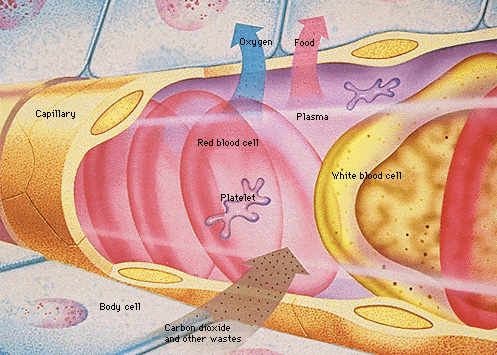
The lymphatic system
consists of a network of tubes that carries a clear, watery fluid called lymph. Lymph comes from the blood and eventually returns to it. Water, proteins, and dissolved food leave the blood through the capillary walls. This fluid, which is known as interstitial fluid, bathes and nourishes the cells of the body tissues. The fluid then drains into tiny, closed-ended tubes called lymphatic capillaries. At this point, the fluid is known as lymph.
The lymph flows through the small tubes into larger and larger lymphatic vessels. Lymph nodes occur at various points along the lymphatic vessels. These beadlike structures produce many white blood cells and filter harmful substances out of the lymph. Eventually, all the lymph flows into either the thoracic duct or the right lymphatic duct. The lymph drains from these ducts into veins near the neck and so rejoins the blood.
The urinary system
The urinary system removes various wastes from the blood and flushes them from the body. The chief organs of this system are the two kidneys. Each kidney has about a million microscopic filtering units known as nephrons. As blood passes through a nephron, a complicated network of capillaries and tubes filters out water, and other wastes called filtrate. Water and substances important to the body are removed and other substances are excreted to produce a yellowish fluid, called urine. Two tubes called ureters transport urine from the kidneys to the urinary bladder, a hollow storage organ. Urine eventually is squeezed out of the bladder by muscular contractions. It then leaves the body through a tube known as the urethra.
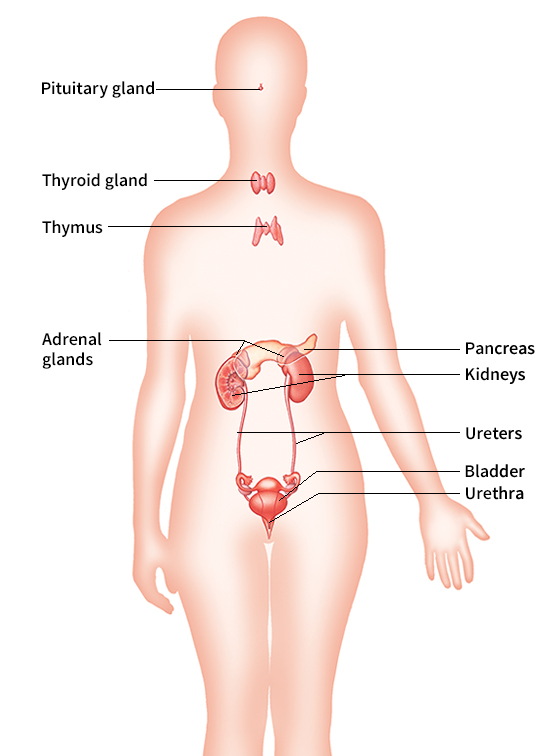
The reproductive system
The organs of the reproductive system enable men and women to have children. Human beings reproduce sexually. Sexual reproduction involves the union of sex cells. A new human being begins to develop after a sex cell produced by the father unites with a sex cell produced by the mother. The father’s sex cells are called sperm, and the mother’s are called eggs. The union of a sperm and an egg results in fertilization. The fertilized egg has all the information necessary for the development of a new human being.
The male reproductive system includes two testicles, which hang between the legs in a pouch called the scrotum. The testicles are glands that produce sperm. The sperm travel through tubes to the penis, an organ in front of the scrotum. Sperm leave a man’s body through the penis.

Most of the female reproductive system lies within the woman’s body. Deep within the body are two glands called ovaries, each of which contains thousands of eggs. Only about 400 eggs will mature during a woman’s childbearing years. About once a month, one of the ovaries releases an egg. The egg travels down a narrow duct called the fallopian tube. The female body has two fallopian tubes, one leading from each ovary. The fallopian tubes open into the top of the uterus, a hollow, muscular organ. The other end of the uterus leads to a canal called the vagina. The vagina extends to the outside of the body, opening between the legs.
During sexual intercourse, sperm from the penis enter the vagina. Each sperm has a tiny tail and can swim. The sperm swim from the vagina to the uterus and into the fallopian tubes. If an egg is present in one of the tubes, a sperm may fertilize it.
The fertilized egg continues its journey to the uterus, where it becomes attached to the wall of the organ. The cell divides over and over, forming the developing baby. Soon, a complex organ called the placenta forms. The placenta enables the developing baby to obtain food and oxygen from the mother’s bloodstream.
After about nine months, the baby is ready to be born. Powerful contractions of the uterus push the baby out through the mother’s vagina, which widens to allow the baby to pass through.
The endocrine system
The endocrine system consists of glands that regulate various body functions. The system plays a major role in regulating growth, the reproductive process, and the way the body uses food. It also helps prepare the body to deal with stress and emergencies.
The endocrine glands control body functions by producing hormones. These molecules are released into the blood, which carries them throughout the body. Hormones act as chemical messengers. After a hormone reaches the organs or tissues it affects, it triggers certain actions. Many hormones have widespread effects. For example, the hormone insulin causes cells throughout the body to take in and use sugar from the bloodstream.

The chief endocrine glands include the adrenal glands, the pituitary gland, the parathyroid glands, and the thyroid gland. Other endocrine glands include the ovary, testis, thymus, and pineal gland. The brain, the kidneys, the stomach, and the pancreas also have endocrine tissues and produce hormones. The pituitary gland, which lies near the base of the brain, is often called the master gland. It releases a number of hormones, which, in turn, regulate other endocrine glands. However, the pituitary itself is controlled by hormones produced by the hypothalamus, a part of the brain. The hypothalamus links the nervous and endocrine control systems.
The body also has glands that do not produce hormones. These exocrine glands make substances that perform specific jobs in the area where they are released. Major exocrine products include the digestive juices, mucus, sweat, and tears.
The nervous system
The nervous system regulates and coordinates the activities of all the other systems of the body. It enables the body to adjust to changes that occur within itself and in its surroundings. The nervous system is made up of countless nerve cells, or neurons. The neurons form a communications network that extends to every part of the body. The nervous system has three main divisions. They are (1) the central nervous system; (2) the peripheral nervous system, which includes the eyes, ears, nose, and other sense organs; and (3) the autonomic nervous system.
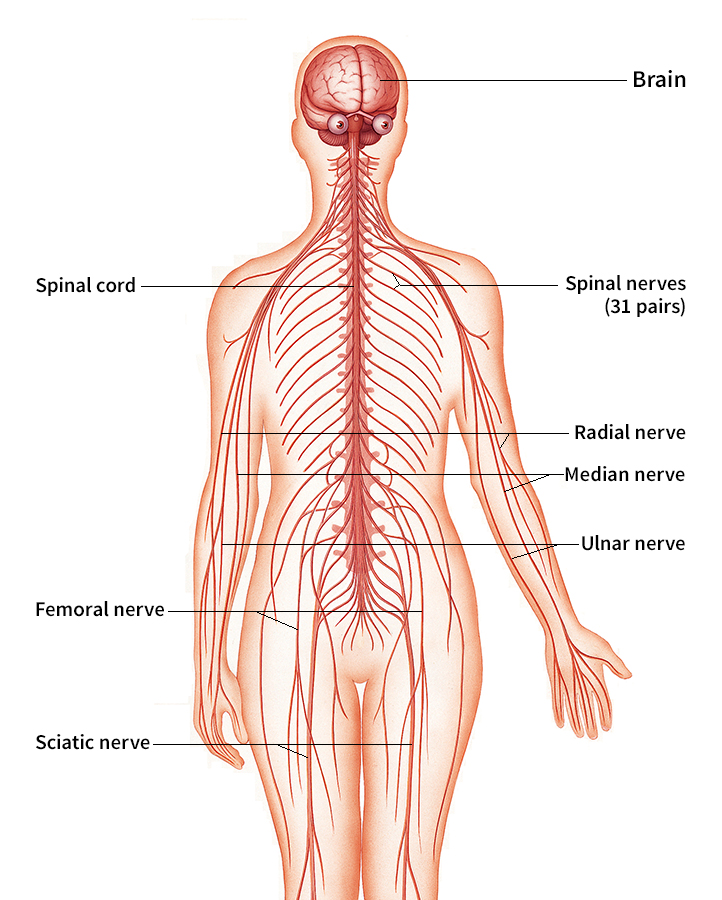

The central nervous system
consists of the brain and spinal cord. It functions as the control center of the nervous system. The central nervous system receives information from the senses. It analyzes this information and decides how the body should respond. It then sends instructions that trigger the required actions.
The central nervous system makes some simple decisions within the spinal cord, such as directing the hand to pull away from a hot object. Such simple decisions are called spinal reflexes. Most decisions, however, involve the brain. The brain is an enormously complicated collection of billions of neurons. These neurons are linked together in precise patterns that enable the brain to think and remember. Much brain activity occurs at the conscious level. We are aware of decisions made at this level and can voluntarily control them. Other activity occurs at the subconscious level. This activity regulates the smooth muscles and is beyond voluntary control.
The peripheral nervous system
is made up of the nerves that connect the central nervous system with every part of the body. These nerves include both sensory neurons, which carry information to the central nervous system, and motor neurons, which relay instructions from the central nervous system.
Sensory neurons run between the sense organs and the central nervous system. The sense organs have special cells called receptors. Receptors translate information about the internal or external environment into nerve impulses. These impulses are electrical signals that nerves can carry.
The body has many kinds of sense receptors. Vision receptors in the eyes change light waves into nerve impulses. Hearing receptors in the ears convert sound waves into nerve impulses. Smell receptors in the nose and taste receptors on the tongue convert chemical information into nerve impulses. Receptors in the skin respond to heat, cold, pressure, touch, and pain. Receptors deep within the body provide information on the chemical and physical conditions of inner body tissues.
Nerve impulses from the sense receptors travel along sensory neurons to the central nervous system. The central nervous system analyzes the information and decides what actions, if any, are necessary. If a response is needed, the central nervous system sends out instructions. The motor neurons of the peripheral nervous system carry the instructions from the central nervous system to the appropriate tissues.
The autonomic nervous system
is a special part of the peripheral nervous system. It carries messages from the subconscious level of the brain to the internal organs. The autonomic nervous system regulates the automatic functions of the body, such as the beating of the heart and the movement of food through the digestive system.
